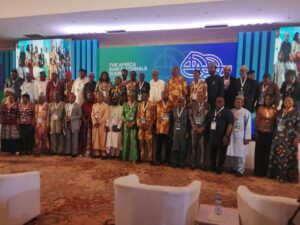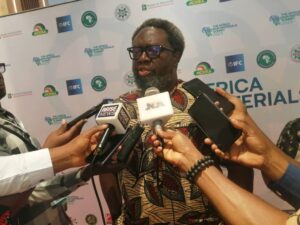FG launches 10 Years Nigeria raw materials roadmap
- May 24, 2025
- 0
By: Goodluck E. Adubazi, Abuja. The Federal Government of Nigeria has launched a 10-year roadmap for the country’s raw materials sector. According to the Honourable Minister of State
By: Goodluck E. Adubazi, Abuja. The Federal Government of Nigeria has launched a 10-year roadmap for the country’s raw materials sector. According to the Honourable Minister of State

By: Goodluck E. Adubazi, Abuja.
The Federal Government of Nigeria has launched a 10-year roadmap for the country’s raw materials sector.
According to the Honourable Minister of State for Industry, Federal Ministry of Industry, Trade and Investment, Senator John Owan Enoh, the purpose of the roadmap is to transform Nigeria’s raw materials sector into a globally competitive industry, driving the structural transformation of the national economy.
“The purpose of the 2025–2034 strategic plan is to position Nigeria’s raw materials sector as a globally competitive force that drives innovation, fosters industrialization, and enhances economic diversification,” the Minister stated.
Standard-Times Nigeria reports that the launch of the roadmap aims to create a robust database for raw materials mapping and development, achieve 30–95% value addition to raw materials by 2034, and attract up to \$200 million in combined public and private investments.
The roadmap hinges on effective monitoring and evaluation, with a strong emphasis on innovation, sustainability, and inclusivity.

Additionally, the strategy aligns with global best practices to improve Nigeria’s competitiveness through continued collaboration with academia, industries, and policymakers, targeting 95% value addition in raw materials processing.
Speaking at the Africa Raw Materials Summit 2025, held from May 20 to 22 at the Abuja Continental Hotel, Ghana’s Minister of Environment, Science and Technology (MEST), Dr. Murtala Ibrahim Muhammed, emphasized the need for sub-regional collaboration and leveraging Nigeria’s population and expertise to develop Africa.
“We need to talk to ourselves; we have to collaborate,” he urged.
The Minister remarked, “Nigeria has very fertile land. You have virtually everything to support agriculture, but we have yet to formulate adequate and comprehensive policies to harness our abundant natural resources.”
He added, “To get there, we must follow some of the suggestions raised during Day 2’s panel session—on research and innovation.”
Continuing, the Minister said, “Your Excellency, four decades ago, African leaders made the ‘Lagos Declaration,’ committing at least 1% of GDP to research and development. Today, the average GDP allocation in Africa is just 0.42%. A society that neglects research cannot innovate. Without innovation, we are left to merely survive on what we have.”
“One way to fully utilize our resources is to invest in research that leads to innovation,” he added.

Citing competing policy decisions as a hindrance, the Minister noted, “Once politicians win elections and are sworn in, their focus shifts to the next election. As a third-term Member of Parliament for Tamale Central, Ghana, I’ve seen how short-term thinking dominates. Investment in research takes time. Some research may take two years to complete, followed by additional years before implementation—bringing the total to 4–6 years.”
Addressing how Africa can navigate competing national and partisan interests, the Minister suggested the continent needs a sub-regional development plan or agenda, coordinated by ECOWAS. “Africa must harness its potential through collective development planning,” he said.
He continued, “The problem with African leaders is that they plan for their people rather than with their people. As a student, a lecturer once told me that. The basic challenges facing Africans remain access to water, food, and healthcare.”
“One major asset we have not fully utilized is our population. Nigeria’s population alone represents nearly one-tenth of West Africa’s total. Countries like China and India have leveraged their large populations to reduce poverty and improve living standards.”
“Nigeria has both quality and quantity—intellectuals and expertise. If we aggregate the sub-region population, we have over 400 million people, representing a massive market. Yet, intra-African trade remains below 20%, while trade with Europe exceeds 60–70%. Africa must collaborate for the benefit of its people and the continent.”
Responding to journalists after the Minister of State for Trade and Investment, Hon. John Enoh, launched the RMRDC’s 10-Year Roadmap, the Director-General of RMRDC, Prof. Nnanyelugo M. Ike-Muonso, said: “We began this journey with the African Development Bank in October last year. Today, we launched the roadmap, and we are ready to hit the ground running with the outcomes of this summit.”
He added, “It’s important to note that the Africa Raw Materials Summit unanimously agreed to approach the African Union to address the issue of political will and mobilize the continent to follow the example Nigeria is setting.”
Prof. Ike-Muonso expressed gratitude to President Bola Ahmed Tinubu for launching the ‘Nigeria First’ agenda, which he said aligns with RMRDC’s initiatives. “As you know, this summit drew inspiration from the President’s UNGA speech two years ago, where he emphasized that Africa should not export raw materials only to import dependency.”
According to the DG, “The ‘Nigeria First’ policy means we will prioritize national interests.”
The Director of Policy and Planning, Dr. Rachel Kotso, delivered the closing remarks, expressing heartfelt gratitude to all participants and partners of the summit, including Mouka Foam, IFC, FIIRO, First Bank, and the Bank of Industry.
The first-ever Africa Raw Materials Summit 2025 drew attendance from diplomats and dignitaries across Nigeria. The event featured cultural performances, awards, and group photographs.